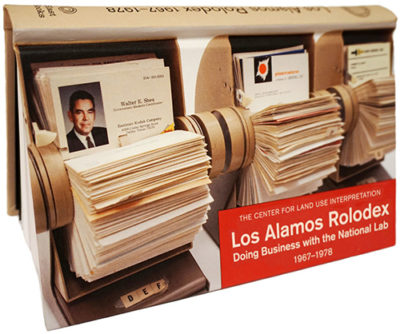
Los Alamos Rolodex
The Center for Land Use Interpretation
Introduction by Matthew Coolidge
Hardcover • 4.25 x 6.75″ • 160 pages
History, Technology • 150 color illustrations • $17.95
ISBN: 978-0-922233-45-8
Publication date: January 19, 2016
Introduction by Matthew Coolidge
In 2012, the Center for Land Use Interpretation acquired a set of seven rolodexes from the dispersed collection of former Los Alamos National Laboratory employee Ed Grothus, who operated a salvage company of lab cast-offs known as The Black Hole.
Now part of the center’s Radioactive Archive, the rolodexes contain many thousands of business cards kept by some unknown office in the lab over the 1960s and 1970s—the peak of the arms race and its technological development. They are a physical record of everything from major military contractors to obscure high—and low-tech software and widget suppliers—many no longer extant, some, like Kodak and Xerox, evolved—all seeking or engaged in business with the Los Alamos nuclear industry.
The selection of 150 cards, presented in an oblong-bound book to simulate flipping through a rolodex, may be viewed as a snapshot of synergies between the business community and America’s atomic might. On the one hand, they are a direct indexical connection from the recent past to the sources of building and operating the most sophisticated and powerful national defense technologies in the world. On the other hand, they are obsolete information, relics of a former usefulness. As a specific printed historical record—superbly reproduced in full color in this volume—they retain relevance for a potential understanding of the present; they are evocative evidence of the links that formed the secret technology of our nation.
